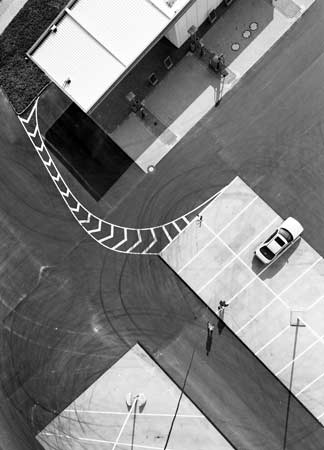|
Spatial Use
The parliamentary
building in Bonn provided the dignified setting:
The exhibition "RaumNutzung" (Spatial Use) was realised
in the foyer of the former Federal Parliament for the "Zukunftsforum
Raumplanung" (Forum on the Future of Spatial Planning).
Examples of settlement forms in Germany were interpreted photographically
by the two colleagues Michael Schroedter and Ralph Hinterkeuser.
Jürgen Hohmuth took photographs again with the aid of his "special
tripod", the photographic airship, in medium formats. A catalogue
can be obtained from the client, the Federal Office for Building
and Regional Planning.
This exhibition is conceived as a travelling exhibition, similarly
to the exhibition "ZeitRaum" produced by "zeitort"
in 1998, which could be seen at the Europa-University Viadrina in
Frankfurt (Oder) in 2001. (Reference: Jena, Dessau, Weimar. Städtebilder
der Transformation. 1988-1990 und 1995-1996. Leske und Budrich 1997).
Extracts from the catalogue to the exhibition "RaumNutzung",
Selbstverlag des Bundesamtes für Bauwesen und Raumordnung,
Deichmanns Aue 31-37, 53179 Bonn, telephone 018 88 - 401 - 2209,
e-mail: selbstverlag@bbr.bund.de
by Prof. D. Wendelin Strubelt:
"Today we are marked almost more by images than by words. Images
have become independent, although not emancipated - how could they
by themselves - , but they are more than only illustrations in the
sense of pictures, they have turned into messages, independent bearers
of significance. And they are used and applied as such...
However, photographs can still claim to be authentic everywhere
today, even if we all know meanwhile that they are produced or even
manipulated - in a positive or negative sense - just like other
images, and that they can therefore be employed either as intentional
glorifications or condemnations in a similar sense. Photographs
have thus become a peculiar amalgam of documentation and propaganda,
the understanding of which requires some insight(!) and education...
This type of the application of photography as a mediating and interpreting
medium in the sectors of science, of political and administrative
practice in urban planning and spatial development, in spatial planning
and spatial research, is unusual in Germany, in contrast to France,
for instance. In France there is a tradition of "continuous
photographic spatial monitoring" by political and administrative
bodies that are responsible for spatial planning. Not only, as in
Germany, to produce beautiful photographic volumes or polemic accounts,
to indicate the whole spectrum of possibilities in our country,
but as a deliberate approach to open the eyes for obvious but also
for hidden spatial constellations with the aid of modern interpretative
photography and exactly not by means of ordered pseudo-documentation.
It is therefore an attempt to develop viewpoints by others than
those who are professionally responsible for spatial planning, but
to confront the latter with these views. It is, as it were, the
attempt to enable a critical but also constructive dialogue between
professionals in their respective fields without submitting to the
temptation to dabble as an amateur in a foreign field. This means
that no amateur photographs should be taken by spatial experts and
no amateur suggestions on spatial design should be made by photographers..."
|

